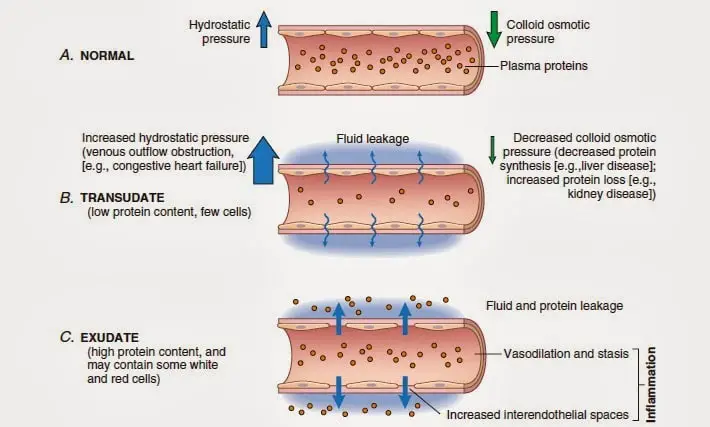The closed cavities of the body—namely, the pleural, pericardial, and peritoneal cavities—are each lined by two membranes, visceral membrane and parietal membrane. There is a small amount of fluid between the membranes that is an ultrafiltrate of plasma. When the production and reabsorption of the ultrafiltrate is not balanced, fluid may accumulate, resulting in effusion. Effusions may be classified as transudate or exudate.
Classifying a serous fluid as transudate or exudate can provide a valuable initial diagnostic step and aid diagnosis of underlying cause. Followings are the differences between transudate and exudate :
| Features | Transudate | Exudate |
|---|---|---|
| Cause | Usually develop from imbalances in hydrostatic and oncotic forces in circulation. | Usually develop from increased capillary permeability or decreased lymphatic reabsorption. |
| Associated with | -Congestive heart failure -Fluid overload -Nephrotic syndrome -Hepatic cirrhosis -Malnutrition | -Microbial infections -Membrane inflammations -Malignancy -Connective tissue diseases. |
| Appearance | Clear, thin-colored, pale yellow | Turbid, hemorrhagic, straw colored |
| Fibrinogen | Low content of fibrinogen (low tendency to clot) | High content of fibrinogen (high tendency to clot) |
| Specific gravity | <1.012 | >1.012 |
| pH | >7.3 | <7.3 |
| Glucose content | Same as plasma | Low (less than 60 mg/dl) |
| Total Protein | Less than 3 gm/dl | More than 3 gm/dl |
| Fluid/Serum Protein | <0.5 | >0.5 |
| LDH | <0.67 x UNL Serum | >0.67 x UNL Serum |
| WBC count | <1000/ul | >1000/ul |
| Differential count | Mesothelial cells or lymphocytes | Polymorphs, lymphocytes or RBCs |
| Culture | Sterile | Positive |

No comments:
Post a Comment
Due to the high number of spammy comments we have decided to initiate comment moderation so that we can maintain our quality standards and make good environment for our visitors. Please leave your comment